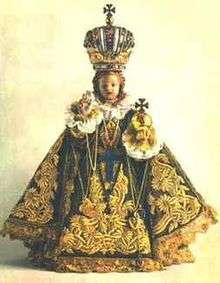Catholic devotions to Jesus
The Roman Catholic tradition includes a number of devotions to Jesus Christ. Like all Catholic devotions, these prayer forms are not part of the official public liturgy of the Church but are based on the popular spiritual practices of Roman Catholics. Many are officially approved by the Holy See as suitable for spiritual growth but not necessary for salvation.
| Part of a series on |
| Devotions to Jesus in the Catholic Church |
|---|
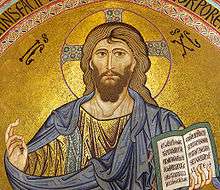 Christ Pantokrator |
| Devotions |
| Prayers |
|
|
Some devotions arise from private revelations, or personal religious experiences of saints. The Church has a tradition of thorough investigation of such private revelations and the lives of candidates for sainthood to assure that no natural or scientific explanation can, at the time of investigation, account for any miracles involved. Often an approved devotion of the Church relates to a particular prayer form, or an image.
Devotion to the Holy Name of Jesus
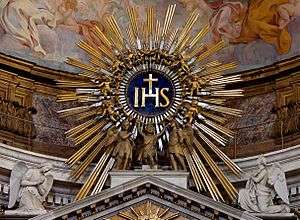
Devotion to the Holy Name of Jesus exists both in Eastern and Western Christianity.[1]
The Gospel of Matthew provides the meaning of the name Jesus as the one who "saves his people from sin" and indicates that it was selected by Heavenly guidance. For centuries, Christians have invoked the Holy Name, and some have believed that there is intrinsic power in the name of Jesus.[2][3][4] St. Paul says, " ...at the name of Jesus every knee should bow, of those that are in heaven, on earth, and under the earth" (Philippians 2:10).
The reverence and affection with which Christians have regarded the Holy Name of Jesus goes back to the earliest days of Christianity.[5] The devotions and venerations also extend to the IHS christogram (a monogram of the Holy Name), derived from the first three letters of the Greek word for Jesus ΙΗΣΟΥΣ (sometimes erroneously interpreted as Iesus Hominum Salvator, Jesus saviour of mankind), representing the Holy Name.[6][2][7]
The feast day is celebrated either as the Feast of the Holy Name of Jesus or as that of Circumcision of Jesus, in various Christian churches. The month of January is dedicated to the Holy Name of Jesus.[8]
Infant Jesus of Prague
The Infant Jesus of Prague is a famous statue of infant Jesus in the Church of Our Lady Victorious in Malá Strana, Prague. The exact origin of the Infant Jesus statue was not truly known, but historical sources point to a small 28 cm high sculpture of the Holy Child with a bird in his right hand carved in around the year 1340. Many other Infant Jesus sculptures were also carved by famous masters throughout Europe in the Middle Ages. The ornate statue depicts the Infant Jesus with his left hand holding a golden orb symbolizing kingship and the right hand raised with the palm in a gesture of blessing.[9] The devotion began in Prague in 1639; the tradition of the Infant Jesus procession and coronation continues to this day. The devotion is also widespread in Ireland. The Feast of the Holy Name of Jesus is the principal feast of the miraculous Infant.[10]
Similarly, the Santo Bambino of Aracoeli is venerated in Rome.
Eucharistic adoration
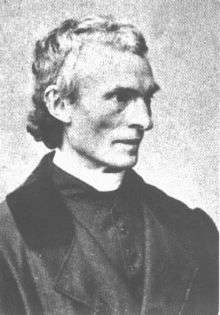
In the Roman Catholic tradition, at the moment of Consecration the elements (or "gifts" as they are termed for liturgical purposes) are transformed (transubstantiation) into the actual Body and Blood of Christ. Catholic doctrine holds that the elements are not only spiritually transformed, but rather are actually (substantially) transformed into the Body and Blood of Christ. The Scholastic philosophical explanation is that although the elements retain the appearance or "accidents" of bread and wine, they are indeed the actual Body, Blood, Soul, and Divinity of Christ. This is one form of the doctrine of Real Presence—the actual, substantive presence of Jesus in the Eucharist.
One of the first possible references to reserving the Blessed Sacrament for adoration is found in a life of St. Basil (who died in 379). The Franciscan archives credit Saint Francis of Assisi (who died in 1226) with starting Eucharistic Adoration in Italy. The lay practice of adoration formally began in Avignon, France on 11 September 1226. The Venerable Leo Dupont initiated the nightly adoration of the Blessed Sacrament in Tours in 1849, from where it spread within France.[11] Leo Dupont interacted with Saint Peter Julian Eymard, who formed the Congregation of the Blessed Sacrament in 1858.[12] The same year, Eymard (also known as the Apostle of the Eucharist) and sister Marguerite Guillot formed the Servants of the Blessed Sacrament which now maintains houses on several continents where continuous Eucharistic adoration takes place.[13]
Holy Hour
The Holy Hour devotion consists of an uninterrupted hour spent in Eucharistic adoration or in prayer in the presence of the Blessed Sacrament.[14] The inspiration for the Holy Hour is Matthew 26:40.[15] In the Gospel of Matthew, during the agony in the Garden of Gethsemane the night before his crucifixion, Jesus spoke to his disciples, saying "My soul is sorrowful even to death. Remain here and keep watch with me" (Matthew 26:38). Returning to the disciples after prayer, he found them asleep and in Matthew 26:40 he asked Peter,"So, could you men not keep watch with me for an hour?"[15]
The official Enchiridion Indulgentiarum provides an indulgence for this practice.[16]
Stations of the Cross
The Stations of the Cross refers to the depiction of the final hours (or Passion) of Jesus. The tradition as a chapel devotion began with St. Francis of Assisi and extended throughout the Roman Catholic Church in the medieval period. It became popular in the eleventh century, at a time when much Christian attention was focused on the Holy Land but few were able to actually visit.[17] Great numbers of Europeans found an equivalent to walking the Via Dolorosa in following Christ's footsteps in spirit. This devotion is traditionally observed on Fridays during Lent, as well as, on Good Friday, but may be prayed at any time. Many will use meditations composed by St. Alphonsus Ligouri, or the scriptural references or other texts, or simply contemplate the depicted event in the life of Jesus.
Holy Face of Jesus
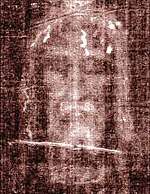
Belief in the existence of authentic images of Christ is connected with the old legend of Abgar of Edessa and the apocryphal writing known as the "Mors Pilati". The oldest and best known of these images, it was called vera icon (true image), which ordinary language soon made Veronica.[18]
In 1843 Sister Marie of St. Peter, a Carmelite nun in Tours, France, reported visions of Jesus and Mary in which she was urged to spread the devotion to the Holy Face of Jesus, in reparation for the many insults Jesus suffered in His Passion. The devotion was further spread by the efforts of the Venerable Leo Dupont (known as the Apostle of the Holy Face). The devotion was initiated shortly before Dupont's death and later influenced Saint Therese of Lisieux.[19] Pope Leo XIII approved of the devotion in 1885.
In 1936, Sister Maria Pierina de Micheli, a nun from Milan in Italy, reported a vision in which Jesus told her: "I will that My Face, which reflects the intimate pains of My Spirit, the suffering and the love of My Heart, be more honored. He who meditates upon Me, consoles Me". Further visions reportedly urged her to make a medal with the Holy Face based on the image from Secondo Pia's photograph of the Shroud of Turin. In 1958, Pope Pius XII approved of the devotion and the Holy Face medal and allowed for the remembrance of the Holy Face of Jesus on Shrove Tuesday (the Tuesday before Ash Wednesday) for all Roman Catholics.[20][21]
Sacred Heart
Devotion to the Sacred Heart of Jesus is based on the heart as a symbol of his love for humanity. In Roman Catholicism, the Sacred Heart has been closely associated with Acts of Reparation to Jesus Christ. In his encyclical Miserentissimus Redemptor Pope Pius XI stated: "the spirit of expiation or reparation has always had the first and foremost place in the worship given to the Most Sacred Heart of Jesus".[22]
Formal references to this devotion first appeared in the eleventh and twelfth centuries.[23] However, the most significant source for the devotion to the Sacred Heart in its present form was Visitandine Saint Margaret Mary Alacoque (1647–1690), who claimed to have received a series of private revelations from 1673 to 1675.
From this developed the First Friday Devotion. The devotion consists of several practices that are performed on the first Fridays of nine consecutive months. On these days, a person is to attend Mass and receive Communion.[24] If the need arises, in order to receive Communion in a state of grace, a person should also make use of the Sacrament of Penance before attending Mass. In many Catholic communities the practice of the Holy Hour of meditation during the Exposition of the Blessed Sacrament during the First Fridays is encouraged.[25]
The Feast of the Sacred Heart is now a holy day in the Roman Catholic liturgical calendar, and is celebrated 19 days after Pentecost. The month of June is dedicated to the Sacred Heart of Jesus.[8]
Precious Blood
The devotion to the Precious Blood was a special phenomenon of Flemish piety in the fifteenth and sixteenth centuries, that gave rise to the iconic image of Grace as the "Fountain of Life," filled with blood, pouring from the wounded "Lamb of God" or the "Holy Wounds" of Christ. The image, which was the subject of numerous Flemish paintings, was in part spurred by the renowned relic of the Precious Blood, which had been noted in Bruges since the twelfth century[26] and which gave rise, from the late thirteenth century, to the observances, particular to Bruges, of the procession of the "Saint Sang" from its chapel.[27] It was also particularly propagated by Gaspar del Bufalo, founder of the Missionaries of the Precious Blood.
The Feast of the Most Precious Blood, formerly celebrated on the first Sunday in July, was removed from the General Roman Calendar in 1969, "because the Most Precious Blood of Christ the Redeemer is already venerated in the solemnities of the Passion, of Corpus Christi, of the Sacred Heart of Jesus, and in the feast of the Exaltation of the Holy Cross. But the Mass of the Most Precious Blood of Our Lord Jesus Christ is placed among the votive Masses".[28] The moth of July is traditionally dedicated to the Most Precious Blood of Jesus.[8]
Holy Wounds
The Crusades brought a renewed enthusiasm for religious devotion, especially for the Passion of Christ. The five Holy Wounds of Christ were the five piercing wounds inflicted upon Jesus during his crucifixion.
Among specific devotions to the Holy Wounds are the Redemptorist's, Chaplet of the Five Wounds of Jesus,[29] the Passionist Chaplet of the Five Wounds,[30] and the Rosary of the Holy Wounds (also called the Chaplet of Holy Wounds), first introduced at the beginning of the 20th century by the Venerable Sister Marie Martha Chambon, a lay Roman Catholic Sister of the Monastery of the Visitation Order in Chambéry, France.[31]
There is a separate devotion regarding the shoulder wound of Jesus. The relevant prayer calls to mind the wound he is said to have received during the carrying of his cross. It is variously attributed to Bernard of Clairvaux,[32] St. Gertrude, or St. Mechtilde.[33] The shoulder wound did not inspire as significant a devotional following as the wound in the side "...with its direct access to Christ's heart."[34]
Divine Mercy
The Divine Mercy is a devotion associated with reputed apparitions of Jesus revealed to Saint Faustina Kowalska. The Roman Catholic devotion and venerated image under this Christological title refers to the unlimited merciful love of God towards all people.[35][36] There are a number of elements of this devotion, among which are: the devotional Divine Mercy image, the Chaplet of the Divine Mercy, and the observance of Divine Mercy Sunday. Pope John Paul II was instrumental in the formal establishment of the Divine Mercy devotion and acknowledged the efforts of the Marian Fathers in its promotion.
Acts of reparation
Reparation is a theological concept closely connected with those of atonement and satisfaction. In ascetical theology, reparation is the making of amends for insults given to God through sin, either one's own or another's. Some devotions have the form of acts of reparation for the sufferings and insults that Jesus endured during His Passion or for the sin of blasphemy. Pope John Paul II referred to Acts of Reparation to Jesus Christ as the "unceasing effort to stand beside the endless crosses on which the Son of God continues to be crucified".[37] Pope Pius XI called these Acts of Reparation "some sort of compensation to be rendered for the injury" with respect to the sufferings of Jesus.[22]
References
- Jesus: the complete guide by Leslie Houlden 2006 ISBN 0-8264-8011-X page 426
- "CATHOLIC ENCYCLOPEDIA: Holy Name of Jesus". www.newadvent.org. Retrieved 2019-04-16.
- Bible explorer's guide by John Phillips 2002 ISBN 0-8254-3483-1 page 147
- Theology of the New Testament by Georg Strecker, Friedrich Wilhelm Horn 2000 ISBN 0-664-22336-2 page 89
- Outlines of dogmatic theology, Volume 2 by Sylvester Hunter 2010 ISBN 1-146-98633-5 page 443
- Christian sacrament and devotion by Servus Gieben 1997 ISBN 90-04-06247-5 page 18
- The Continuum encyclopedia of symbols by Udo Becker 2000 ISBN 0-8264-1221-1 page 54
- Holweck, Frederick. "Special Devotions for Months." The Catholic Encyclopedia Vol. 10. New York: Robert Appleton Company, 1911. 27 April 2020

- Norbert C. Brockman (2011). Encyclopedia of Sacred Places, 2nd Edition. ABC-CLIO. pp. 236–238, 54–56, 462. ISBN 978-1-59884-655-3.
- Davies, O.Carm., Peter. "The Miraculous Infant Jesus of Prague"
- Dorthy Scalan. The Holy Man of Tours. (1990) ISBN 0-89555-390-2
- Joan Carroll Cruz, OCDS, Saintly Men of Modern Times. (2003) ISBN 1-931709-77-7
- Letellier, Arthur. "Congregation of the Servants of the Most Blessed Sacrament." The Catholic Encyclopedia Vol. 13. New York: Robert Appleton Company, 1912. 8 April 2017
- "The New Catholic Dictionary". Archived from the original on 2009-09-29. Retrieved 2011-02-14. Cite journal requires
|journal=(help) - Peter Stravinskas, 1998, Our Sunday Visitor's Catholic Encyclopedia, OSV Press ISBN 0-87973-669-0 page 498
- "Enchiridion Indulgentiarum quarto editur". www.vatican.va. Retrieved 2019-04-16.
- "Stations - Printer Friendly". onlineministries.creighton.edu. Retrieved 2019-04-16.
- Dégert, Antoine. "St. Veronica." The Catholic Encyclopedia Vol. 15. New York: Robert Appleton Company, 1912. 9 April 2017
- Dorthy Scallan. The Holy Man of Tours. (1990) ISBN 0-89555-390-2
- Joan Carroll Cruz, OCDS. Saintly Men of Modern Times. (2003) ISBN 1-931709-77-7
- Holy Face Devotion http://www.holyfacedevotion.com/timeline.htm
- Miserentissimus Redemptor Encyclical of Pope Pius XI
- Bainvel, Jean. "Devotion to the Sacred Heart of Jesus." The Catholic Encyclopedia Vol. 7. New York: Robert Appleton Company, 1910. 8 April 2017
- Roman Catholic worship: Trent to today by James F. White 2003 ISBN 0-8146-6194-7 page 35
- Meditations on the Sacred Heart by Joseph McDonnell 2008 ISBN 1-4086-8658-9 page 118
- Evelyn Underhill, "The Fountain of Life: An Iconographical Study", The Burlington Magazine 17.86 (May 1910, pp. 99–101) p.100.
- The first historian of the "Saint Sang" was the Abbé Carton, "Essai sur l'histoire du Saint Sang", Bruges, 1857. (noted Underhill 1910:100 note).
- Calendarium Romanum (Libreria Editrice Vaticana 1969), p. 128
- Liguori, Alfonso Maria de'; Grimm, Eugene (1887). The passion and the death of Jesus Christ. New York Public Library. New York : Benziger Brothers.
- "Chaplet of the Five Wounds". www.cpprovince.org. Retrieved 2019-04-16.
- Ann Ball, 2003 Encyclopedia of Catholic Devotions and Practices ISBN 0-87973-910-X
- Catholic Online - Prayers
- Preces Gertrudianae sive vera et sincera medulla precum potissimum ex revelationibus BB. Gertrudis et Mechtildis excerptarum. Editio nova, accurate recognita et emendata a monacho ordinis S. Benedicti Congregationis Beuronensis, 1903
- Sargent, Emily Jo. "The Sacred Heart: Christian Symbolism", The Heart, (James Peto, ed.), Yale University Press, 2007, ISBN 978-0300125108
- "Loving Mercy". Sed Contra. Archived from the original on 27 November 2014. Retrieved 15 November 2014.
- Ann Ball, 2003 Encyclopedia of Catholic Devotions and Practices ISBN 0-87973-910-X page 175
- Vatican archives https://www.vatican.va/holy_father/john_paul_ii/letters/2000/documents/hf_jp-ii_let_20001021_riparatrici_en.html
![]()
External links
- Devotions
- EWTN Faith Devotionals
- Several Devotions
- Herbermann, Charles, ed. (1913). . Catholic Encyclopedia. New York: Robert Appleton Company.
